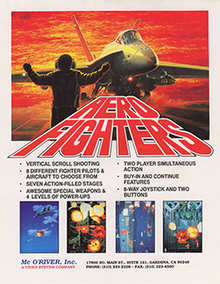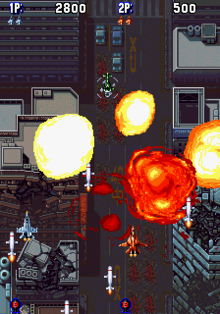Aero Fighters
| Aero Fighters | |
|---|---|
 Arcade flyer | |
| Developer(s) | Video System |
| Publisher(s) |
|
| Designer(s) | Shin Nakamura |
| Composer(s) | Naoki Itamura |
| Platform(s) | Arcade, Super NES |
| Release | |
| Genre(s) | Scrolling shooter |
| Mode(s) | Single player, 2 player co-op |
Aero Fighters, known as Sonic Wings (ソニックウィングス, Sonikku~uingusu) in Japan, is a vertically scrolling shooter originally released in arcades in 1992 by Video System and ported to the Super Nintendo Entertainment System in 1993. It was the first in the Aero Fighters series, and a spiritual successor to the 1991 Turbo Force.
Gameplay

This section needs additional citations for verification. (April 2016) |
This game uses basic shooter mechanics. Pressing button 1 fires normal weapons; this can be upgraded by collecting P or the rare F items, though the maximum power level has a hidden ammo count, after which the player will return to the previous power level. Pressing button 2 launches a powerful special attack; uses are limited to how many B items the player has collected (every life starts with two). Some ground enemies will drop score items when destroyed; they appear as the currency of the selected character's nation. By default, players start with three lives, and can acquire one more at 200,000 points.
Aero Fighters is famous for its large cast of characters, unheard of in 1992. Each pair of characters represents one of four nations. The two-player sides may only select the four characters given (one for each nation). In a two-player game, only a single nation can be chosen.
| Country | Player 1 | Player 2 |
|---|---|---|
| United States | Blaster Keaton (F/A-18 Hornet) | Keith Bishop (F-14 Tomcat) |
| Japan | Hien (FSX) | Mao Mao (F-15 Eagle) |
| Sweden | Kohful The Viking (AJ-37) | Tee-Bee 10 (JAS 39 Gripen) |
| United Kingdom | Villiam Syd Pride (AV-8 Harrier II) | Lord River N. White (Tornado IDS) |
The game has seven stages divided into two parts. The first three stages are selected randomly from a group of four, with one for each character's nation; however, a character will never go to its nation's stage. The other four stages are fixed. After beating all seven stages, the player sees the character's ending, then play much more difficult versions of those stages, after which the game truly ends.
Release
Video System Co., Ltd. (ビデオシステム株式会社) was a software company that was founded and ran by software designer Koji Furukawa in Kyoto, Japan in December 1984. It was best known for making video game titles for the arcades,[1] though it also made games for other platforms, including the Super NES, Neo-Geo and Nintendo 64. Video System released arcade games throughout Japan and the U.S., such as Tail to Nose, the F1 Grand Prix series, Karate Blazers, Tao Taido, Rabbit Punch (known as Rabio Lepus in Japan), Turbo Force, Super Volleyball, Super Slams (published by Kaneko), and the Aero Fighters series.
Although Video System's main headquarters opened in Japan, they eventually opened a U.S. branch office. Sometime in 1992, Video System's U.S. office changed its name to McO'River, Inc., and was given the licensing rights to distribute Aero Fighters arcade machines throughout the United States. Aero Fighters was ported to the Super NES in 1993, first released in Japan. This version is different from the arcade original, but is based heavily on it. It adds Rabio (player 1 side) and Lepus (player 2 side) from Video System's earlier Rabio Lepus as playable characters. The same year, McO'River was supposed to publish 3 Super Famicom ports of arcade games in the U.S. While Video System developed and published numerous titles in Japan, McO'River was only able to publish 2 of them in the U.S.: Hyper V-Ball in June, 1994; and Aero Fighters in November, 1994. While the former is an easy-to-find game, the latter is considered by video game collectors to be one of the rarest games ever released on the Super NES.[2]
Reception
This section needs expansion. You can help by adding to it. (September 2013) |
In Japan, Game Machine listed Aero Fighters on their May 1, 1992 issue as being the second most-successful table arcade unit of the year.[3]
GamePro gave the Super NES version a negative review, saying the weapons are imaginative but the game suffers from slowdown, mediocre graphics, weak sound effects, and "monotonous" music, concluding "Aero Fighters' action won't stay with you - it's a temporary thrill that eventually retreats to the hanger."[4]
Legacy
An emulated version of the game was released in 2005 for the PlayStation 2 as part of the Japan-exclusive Oretachi Gēsen Zoku series.
Sequels
This section possibly contains original research. (October 2019) |
Shin Nakamura, the main designer of Aero Fighters and a number of other Video System games, disliked the company's plan to start developing on the Neo Geo. He wanted to make more vertical games like Aero Fighters, but found it difficult to do so on a horizontal monitor. He and other like-minded employees left to found Psikyo, with the similar Samurai Aces being their first game.
McO'River would never publish another title under that name. Back at Video System, meanwhile, other employees teamed up with the remaining Aero Fighters staff to begin work on sequels. Aero Fighters 2 and Aero Fighters 3 were released for the Neo Geo. Sonic Wings Special, a sort of "dream match" game based on the three previous entries, was released for the Sega Saturn and later for the PlayStation. Soon after, Special was reworked for the arcades into Sonic Wings Limited. In 1997, McO'River, Inc. changed its name to Video System U.S.A., Inc.[5] A year later, Paradigm Entertainment developed Aero Fighters Assault for Video System. Sonic Wings Special and Limited were both made for a vertical monitor like the first game. Similarly, Nakamura would make Strikers 1945 Plus for the Neo Geo a few years later.
In popular culture
YouTube celebrity and famous author John Green, having coming across the game in the Savannah Airport, mistakenly read the title as "Nerd Fighters" while filming a video post addressing his brother Hank Green on the popular YouTube channel Vlogbrothers on February 17, 2007.[6] "Nerdfighters" and "Nerdfighteria" eventually became the collective title of the Vlogbrothers' fan community.[7] On September 2013, he was given an Aero Fighters arcade cabinet as a gift.[8]
References
- ^ "'97 Tokyo Toy Show". Electronic Gaming Monthly. No. 94. Ziff Davis. May 1997. p. 88.
- ^ Racketboy (November 28, 2013). "The Rarest and Most Valuable Super Nintendo (SNES) Games". Racketboy. Retrieved 2014-02-23.
- ^ "Game Machine's Best Hit Games 25 - テーブル型TVゲーム機 (Table Videos)". Game Machine (in Japanese). No. 425. Amusement Press, Inc. 1 May 1992. p. 25.
- ^ "ProReview: Aero Fighters". GamePro. No. 61. IDG. August 1994. p. 60.
- ^ IGN staff (August 6, 1997). "Mc O'River Renames Itself". IGN. Retrieved 2010-02-04.
- ^ Braun, Eric (2015). John Green: Star Author, Vlogbrother, and Nerdfighter - Gateway Biographies. Lerner Publications. pp. 23, 24. ISBN 1467772615. Retrieved 26 March 2016.
- ^ Dean, Michelle (March 13, 2013). "A Note on Nerdfighters". The New Yorker. Advance Publications. Retrieved October 25, 2014.
- ^ Green, John. "Secrets of the Movies: Thoughts from The Fault in Our Stars Set".
External links
- Official website
- Aero Fighters at MobyGames
- Aero Fighters at Arcade-History
- Aero Fighters playable at the Internet Archive
